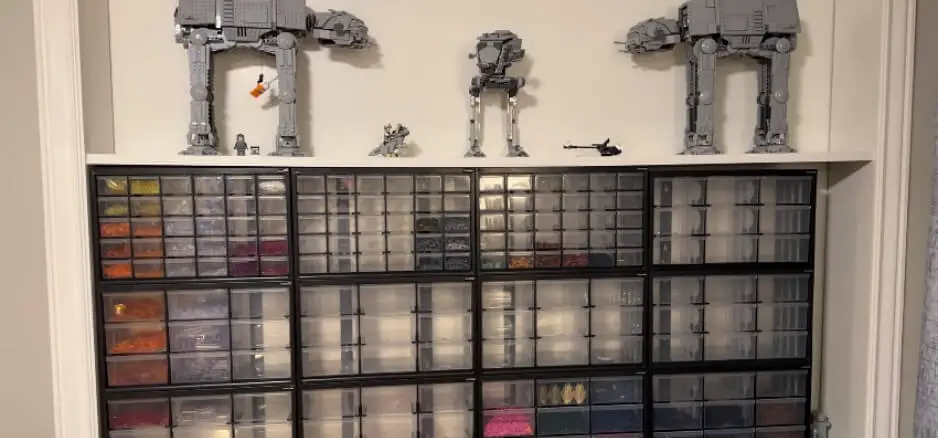As an Amazon Associate I earn from qualifying purchases.
Welcome to the definitive resource for information about how to organize Lego sets. Lego isn’t just a toy; for many, it’s a passion across generations. Building with these bricks brings joy, but organizing them can be a challenge. In this guide, we’ll explore the benefits of an organized Lego set, share sorting tips, storage practices, and creative DIY ideas. Lego is a culture that fosters problem-solving, creativity, and patience. The process of construction is as rewarding as the end result. Knowing how to organize Lego sets well-organized collections enhance building experiences, so we delve into sorting, storing, and enjoying Lego in this guide.
Benefits of Organizing Your Lego Collection
The chaos of a disorganized Lego pile can often be counterproductive to the peaceful and imaginative building session that many enthusiasts crave. An organized Lego sets collection empowers builders with efficiency, creativity, and preserves the sets for years of enjoyment.
- Efficiency in Building: Imagine the frustration of hunting for a specific piece, only to find it missing or buried under a mountain of Lego sets. Organized collections facilitate a faster, more efficient build, making the creative process more enjoyable and satisfying.
- Preservation of Sets: Lego sets are more than just child’s play; for some, they are collectors’ items or valuable relics. Organizing your Lego ensures that pieces are not lost or damaged, maintaining the integrity of the sets for future display or potential resale.
- Enhanced Creativity: A tidy and well-kept collection invites more imaginative play. With organized Lego sets, builders can more easily visualize and execute complex designs, pushing the limits of what they can create.
Tips for Sorting Lego
Throwing all of your Lego sets into a single bin might seem convenient at the time, but the chaos that ensues is far from ideal. Here are some tips to consider when sorting through your Lego pieces:
Approach 1: Sorting by Color, Size, Type
One of the most popular sorting methodologies is to divide pieces by color, size, and type. This allows for quick location of the specific elements you need during a build, enhancing efficiency and reducing frustration.
Pros of This Method:
- Easy to Find: Saves time searching for a specific color or shape.
- Visual Appeal: You may use color-sorted bits as accent pieces to add some style to your desk.
- Educational: Can help younger Lego sets enthusiasts to learn colors and shapes.
Cons of This Method:
- Redundancy: Can lead to multiple categories of the same type and color, increasing the number of containers needed
- Complexity: Sorters often find difficulty in categorizing certain pieces due to their versatility
Approach 2: Using Storage Containers
From stackable bins to compartmentalized trays, there are numerous container options available for sorting Lego sets. The size of the collection and the amount of storage space available may influence the container selection.
Pros of Using Storage Containers:
- Customization: Various shapes and sizes cater to different types of Lego pieces.
- Mobility: Easy to move and sort pieces in different parts of the house or during travel.
- Preservation: Can help protect small and delicate pieces.
- Organization: Clearly defined spaces can lead to a more organized overall system.
- Spill Prevention: Reduces the risk of pieces spilling and mixing.
Cons of Using Storage Containers:
- Space: Takes up additional space, especially as the collection grows.
- Access: Large collections can make it hard to locate pieces within various containers.
Approach 3: Labeling Systems
After sorting your Lego parts into containers, identifying them may really make a big difference. It ensures that every piece returns to its designated spot, making cleanup a breeze and finding pieces a quick task.
Pros of Implementing a Labeling System:
- Clarity: Clearly identifies the contents of each container.
- Consistency: Encourages the user to maintain the organization.
- Familiarity: Maintains the order of organization during collections used by multiple people.
Cons of Implementing a Labeling System:
- Time-Consuming: Initial labeling of containers can be a time-consuming task.
- Customizability: Labels may need to be adjusted or redone as the collection grows and changes.
Best Practices for How to Organize Lego Sets
With the Lego sets pieces sorted, it’s time to consider storage practices. The key is to find a system that allows for ease of access and preserves the organization you’ve painstakingly set up.
Shelving Solutions
Shelves offer a great way to economically store and display Lego sets. They keep the buildable sets intact, accessible for play, and safe from dust or damage.
Pros of Shelving Solutions:
- Visibility: With the sets on display, it’s easy to see and choose what to build.
- Space-Saving: Utilizes vertical space, leaving floor space open for other uses.
- Organization: Encourages the sorting and storage of Lego themes or sets together.
Cons of Shelving Solutions:
- Vulnerability to Dust: Open shelves can expose sets to dust, requiring regular cleaning.
- Accessibility: High shelves may be challenging for younger enthusiasts to access without help.
Drawer Organization
For smaller pieces and sets, drawers can be the ideal storage solution. They keep pieces clean, sorted, and easy to find.
Pros of Drawer Organization:
- Compartmentalization: Provides a separate space for various types of pieces, leading to easier location.
- Stackability: Allows for multiple units to be stacked, maximizing vertical space.
- Protection: Closed drawers can help protect pieces from dust and damage.
Cons of Drawer Organization:
- Limited Visibility: Contents may be less visible than those on open shelves, requiring more labels or memory.
- Weight Consideration: Large, full drawers can become heavy and hard to move.
Portable Cases and Display Options
For the Lego sets enthusiast on the go or those with limited space, portable cases and display options offer a versatile way to store and showcase collections.
Pros of Portable Cases and Display Options:
- Mobility: Ideal for portable collections or for taking Lego on trips.
- Protection: Closed cases can protect from dust and damage.
- Creative Display: Some options double as display cases, showing off prized builds.
Cons of Portable Cases and Display Options:
- Size Restrictions: Space within portable containers may limit the size and number of sets they can hold.
- Accessibility: Can make finding and accessing pieces more challenging, as with closed drawers.
DIY Ideas for Lego Organization
For those who relish the hands-on approach, DIY projects can provide unique and personalized solutions to Lego organization.
Customized Storage Solutions
Creating custom storage solutions designed to fit your particular collection is not only practical but also a creative endeavor in itself.
Examples of Customized Storage Solutions:
- Built-in organizer walls: Constructing play areas with built-in walls featuring small divots in various sizes to hold Lego pieces.
- Under-table storage: Using the space under a Lego sets table to create slide-out trays for quick and easily accessed brick storage.
Repurposing Household Items
An eco-friendly and cost-effective approach to Lego sets storage involves repurposing common household items to serve a new Lego-related purpose.
Ideas for Repurposing Household Items:
- Tackle boxes: Often come with adjustable compartments perfect for sorting Lego pieces.
- Ice cube trays: Great for sorting and temporarily holding smaller pieces during a build.
Building Lego Organization Stations
What could be more meta than using Lego bricks to organize other Lego bricks? Building your organizer or sorting system ensures it will uniquely suit your needs.
Building Ideas for Organization Stations:
- Lego drawers or shelves: Constructing containers or display shelves from Lego bricks to integrate with your collection.
- Lego sorting machines: Advanced builders can create custom machines that sort and separate bricks based on specific criteria.
Conclusion
In this comprehensive exploration of how to organize Lego sets, we’ve dived deep into the benefits, the methods, and the storage practices that can transform your Lego experience. From the creative sorting by color or type to the use of portable cases, the possibilities are endless. For every Lego sets enthusiast, from the casual builder to the seasoned collector, a well-organized Lego collection is the foundation for an optimized and enjoyable building process.
Frequently Asked Questions
Q1. How to organize Lego sets by color?
Answer: First, gather all the pieces of a particular color and sort them into separate containers. Then, label each container with the corresponding color and arrange them in a specific order based on your preference.
Q2. How can I keep my Lego collection organized while building sets?
Answer: Use small bowls or trays to hold pieces for each step of the build process. Once completed, return the pieces to their designated storage containers.
Q3. Are there any organizing tools specifically designed for Lego?
Answer: Yes, the Lego Group offers a variety of storage and organization solutions that align with the iconic brand’s philosophy of play. These include color-sorted brick boxes, stackable drawers, and even Lego-shaped storage containers.
Q4. Does organizing my Lego help with maintaining their value?
Answer: Yes, for collectors, maintaining the organization and integrity of Lego sets can significantly impact their value over time, making them more appealing on the resale market.
Q5. How can I teach my children to organize their Lego sets?
Answer: Start by involving your children in the organization process, explaining the various sorting methods and allowing them to choose their own system. Make it a fun, collaborative project that will benefit them in the long run as they learn to appreciate order and cleanliness in their play space.
Disclaimer: This blog post’s content is solely intended for informative and educational reasons. While the safety and storage of any products, items, or materials, including those of the Lego Group, are addressed, it is important for readers to use their best judgment and any provided advice in accordance with their specific circumstances and the manufacturer’s guidelines.
Personal Experience: As a lifelong Lego enthusiast and organization aficionado, I’ve experienced first-hand the impact of a well-sorted and stored Lego collection. There’s something deeply satisfying about the efficiency and ease that comes from a container of neatly sorted Lego pieces. This approach has not only enhanced my building experience but has also instilled a sense of discipline and order that carries over into other aspects of my life.
Why Trust Our Content?
The information in this blog post is meticulously researched and compiled with the Lego enthusiast in mind. We have drawn on collective knowledge, industry expertise, and personal anecdotes to create a resource that is genuinely valuable to those looking to enhance their Lego lifestyle. Our commitment to thoroughness, accuracy, and creativity ensures that every reader can trust our content to provide the best possible guidance on this engaging topic. Remember, with great organization comes great Lego power!
As an Amazon Associate I earn from qualifying purchases.

